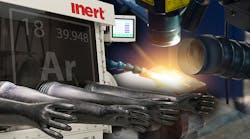Improving Quality by Laser Welding in a Digitally Controlled Atmosphere
As component and subsystem manufacturers in military and aerospace are relying more heavily on the precision of laser welding over other welding techniques―such as Arc or Tig welding―they’re also under continuous pressure to improve their quality levels and lot-to-lot traceability. Though laser welding procedures have long been performed “under the hood” in non-pressurized and negatively pressurized gloveboxes or enclosures, next-generation laser welding systems are now being engineered in positively pressurized gloveboxes with controlled atmospheres. With these systems, purifying gas (typically Argon) is introduced and monitored to create an optimal environment in which to laser weld.
What’s driving the need for clean-room-like laser machining?
Though laser welding is a well-known process offering high precision with low heat affected zones (HAZ) and minimal debris generation, less understood have been the ramifications of variations in atmospheric conditions in an enclosure, and especially at the point of contact. High performance and costly materials often used by mil/aero and medical OEMs, such as titanium and magnesium, for example, have been discovered to routinely produce oxides as a by-product. These oxides are chemically produced through natural reaction of these materials to the laser, as well as variables related to the types and levels of gases introduced. The naturally occurring gases produced from various laser welding processes can also be hazardous to operators if inhaled. Compressed gases, exposed plasmas, and uncovered heated surfaces can also be extremely volatile. For these reasons, and for reasons of total quality management and adherence to ISO and OEM requirements for lot-to-lot documentation, premier manufacturers are moving toward optimal management of the atmospheric conditions of their laser welding procedures.
Understanding the two levels of atmospheric monitoring and control
A proven solution that can prevent many of the issues mentioned above—and even improve manufacturing workflow at-large—is the integration of your laser welding process into a hermetically sealed glovebox or enclosure which is connected to an argon gas line. In lower cost systems of this nature, the argon is introduced by an operator by hand, is visually monitored by the operator reading a gauge, and then purged by the operator at designed intervals. The operator stops any processing during the purge and re-introduction stage until optimal atmospheric levels are re-established.
At a higher cost, but with a more rapid ROI, more robust systems include digital gas control and monitoring (or gas management) systems. For mil/aero and medical device manufacturing especially, the added benefits of choosing a system with advanced gas management are extremely high. They provide efficient argon gas control, monitoring, and regeneration (via closed-loop filtration), while continuously adjusting to maintain an optimal environment. (Typical goal is <1 PPM). As a result of stopping and purging less often, these systems also offer the highest throughput levels.
Advanced manufacturers are also saving on material waste, processing gas, machine maintenance, and downtime
Since the efficiency of a gas managed glovebox is approximately equivalent to a class 10 clean room, manufacturers are provided the added benefit of operating their laser machines under the cleanest and safest conditions possible. As a result, they run without maintenance for longer periods of time. This creates bottom line savings both in laser machine repair and refurbishment, and reduction of downtime and accidents. As the pure atmosphere also improves quality of parts in process and reduces rejects, raw material and rework costs also go down. The filtering and regeneration of the gas also allows manufacturers to procure lower purity/lower cost original source gas, and then use it many times over before purging it and refilling the glovebox.
Explore the advantages of gas management further by visiting: https://www.inerttechnology.com/gas-management-systems/
Conclusion
For the latest applications employing high performance materials, and where cost, reliability, repeatability, and traceability are key business drivers, laser welding in a controlled gas atmosphere becomes a serious consideration. If a digitally-controlled gas management system is used, the expense of such a system is more readily recouped, than a hermetic enclosure using only manual gas control.
About Argon:
Argon is recognized for reducing or eliminating oxides that form on metal surfaces, even under extreme heat and pressure. It is also a known shielding and/or processing gas. In unpressurized, non-hermetic laser welding systems it is delivered at the point of the weld, essentially displacing the ambient atmosphere and debris as the laser welding takes place. In a pressurized, hermetic enclosure, argon is used to condition the entire work space inside the enclosure and is largely unnecessary as a defined “process” gas.
Other commonly used gases for shielding and finishing during laser processes are helium, and to a lesser degree, carbon dioxide. Nitrogen is also used with other welding techniques. These gases are also often rendered unnecessary by laser welding in an inert atmosphere created by argon. It is generally understood, that the purity of argon gas can vary from supplier to supplier, and from delivery to delivery.










